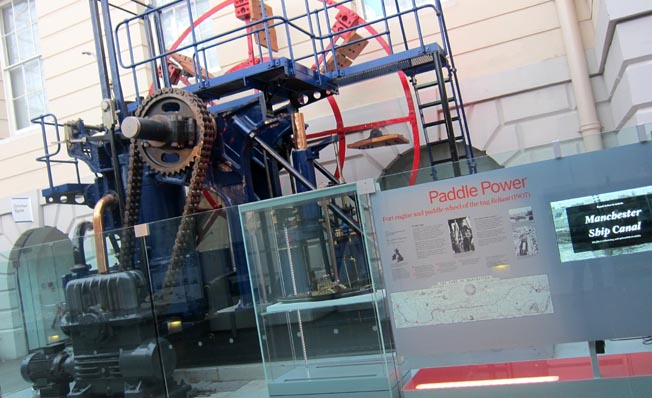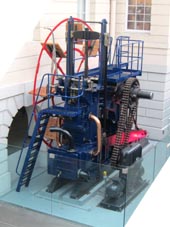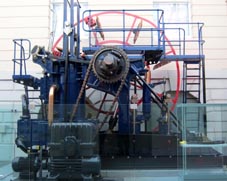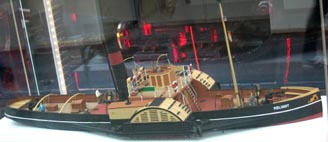一枚の特選フォト⌈海 & 船⌋
One Selected Photo "Oceans & Ships"
Back to: Top Page |
両舷外輪式タグボート ⌈リライアント号⌋
[蒸気エンジンによる外輪推進システムの実物展示]
[英国グリニッジ/国立海洋博物館]

|
画像は英国グリニッジの「国立海洋博物館」に展示される、タグボート⌈リライアント号⌋の
両舷外輪式 (パドル式) 推進器と、それを駆動させた蒸気エンジン (左舷/ポート側) の実物である。 1907年に建造された⌈リライアント号⌋は、当初⌈オールド・トラフォード号⌋と名付けられていた。 同船は、リバプール市街を流れ下るマージー川とグレーター・マンチェスターとの間の36マイル (58km) の人工水路である ⌈マンチェスターシップ運河⌋(Manchester Ship Canal)のために建造された。 タグボートはこの狭い運河では不可欠なものであった。船舶操縦というものは微速では困難である。 タグの主な業務は大型商船の前後に付き添い安全に誘導することであった。従って、タグのスキッパー(船長)は熟練を要した。 何故、プロペラ式でなくパドル (外輪・外車) 式なのか? マンチェスターシップ運河の幅員と水深は限られており、パドル式推進器で 駆動されるタグは利点をもっていた。 外輪はプロペラと違って浅い水域でよく作動する。一方の外輪を他方より速く回転させることで、狭い水域でもタグを容易に操船することが できた。また、外輪式タグは、前進でも後進でも同じパワーで進むことが出来きた。このことは、大型商船をスピードダウンさせるのに プロペラ式推進タグに比してより大きな柔軟性をもっていた。外輪の水受け板 (水掻き板・ブレード) は、もともと空気抵抗を減らすために、 水平な状態になって戻されて行く。そして、ブレードが水に入る時には、垂直に近いポジションで回されることになり、 最大のパワーが発揮された。
展示説明パネルには次のように記されている。
Waterline model of the Reliant (1907). Made by Bassett-Lowke Ltd in 1979. Scale: 1:38.4 Trusty Tugs The paddle wheels of the Reliant were powered by two steam engine. This is the port (left) engine with one side of the paddle wheel attached to it. Originally named Old Trafford, Reliant was built for the Manchester Ship Canal, a 36-mile man-made channel connecting the River Mersey to Greater Manchester. Tugs were vital on the narrow Canal. Ships are difficult to manoeuvre at slow speeds. The tug's main work was at the front and back of large merchant ships, guiding them safely. It required great skill from the tug skipper (captains).
Today, powerful tugs play an important role all over the world in
assisting ships carrying cargoes like containers, coal, oil and grain into ports and docks.
Why paddle instead of propeller? The limited width and depth of the Mancester Ship Canal meant that paddle tugs had an advantage. Paddle wheels work well in shallow water, unlike propellers. A paddle tug can manoeuvre in a smaller space by setting one wheel to run faster than the other.
Paddle wheels also drive with the same power backwards and forwards. This gave greater flexibility in slowing large merchant ships
down compared to propeller-driven tugs. 1. Eastern Lock is the main entrance to the Manchester Ship Canal from the River Mersey. The five main locks on the Canal allow the water level to rise by 60 feet (18 m) between Eastham and Manchester. 2. The Canal is 36 miles long (58 km) and about 28 feet deep (8.5 m). Tugs manoeuvre slow-moving ships into the relevant docks along the canal or in Manchester. 3. The Manchester Ship Canal is part of a large network of connected canals in England. Many of these were constructed during the 18th century. 4. Railways were built alongside the docks to take goods inland. Some of these pass over the Canal on viaducts. 5. The Manchester Docks cover two sites: the Pomona Docks in Manchester, intended for coastal trade, and the Salford Docks for larger vessels. |
 2 2 3  2. [拡大画像: x25684.jpg] 3. 水線より上部のリライアント号模型は、1979年に製作されたものである。 [拡大画像: x25752.jpg] * [拡大画像: x25753.jpg: "Paddle Power"][拡大画像: x25754.jpg: "Trusty Tugs"][拡大画像: x25755.jpg: "Why paddle?"] |
Back to: Top Page |